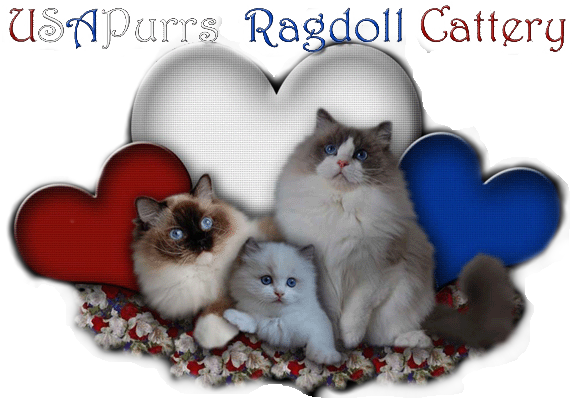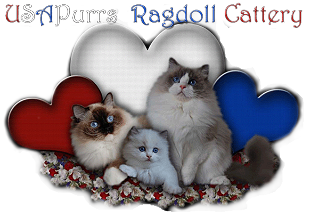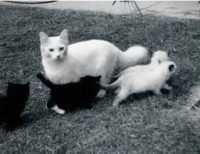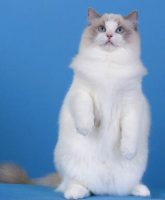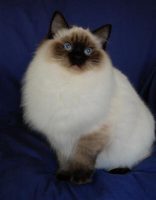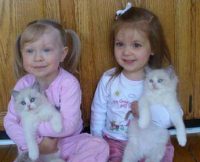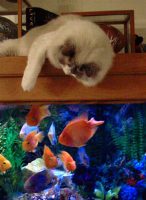Ragdoll History:
Ragdolls were developed in the 1960’s by Ann Baker ; a breeder in California. She bred Josephine, a loving, gentle, longhaired white female carrying Siamese (pointed) markings, to other longhaired cats carrying Siamese markings. Her original stock consisted of sturdy, free-roaming cats. By selecting individuals with the look she wanted for her breeding program, she created the type standard for the Ragdoll.
(Click to enlarge)
- (Josephine featured with her kittens Gueber, Mitts, Tiki and Kyoto. This litter of two pointed and two non-pointed kittens were the first of their breed!)
- (Ann Baker holding Kookie, Toy Sue and Kookie Tu, early Ragdolls born in 1966.)
![]()
Ragdoll Description:
Ragdolls are easily described as a large, pointed cat with blue eyes. Ragdoll males average 14-18 pounds, although it is not uncommon for an altered male to reach 20 pounds or more. Ragdoll females are proportionately smaller usually averaging 9-13 pounds. The Ragdoll is a slow maturing breed. Ragdoll kittens are born pure white and can take up to two weeks before accurate color and pattern can be determined. Ragdolls will grow very slowly and take up to 3-4 years to reach full color and weight maturity.
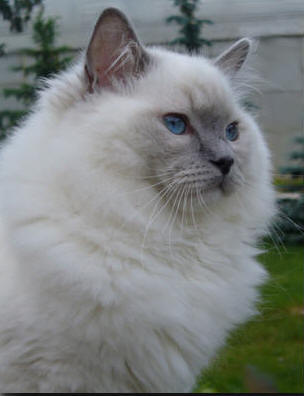
Blue Mitted Ragdoll
![]()
Ragdoll Colors:
Ragdolls are a pointed cat meaning they have a darker color on their ears, tail, legs, and mask with a lighter shade of the same color to the rest of their bodies. Traditional Ragdoll colors are Blue (slate gray) and Seal (dark brown). Non-traditional or “new” colors are Lilac, Chocolate, Red, and Cream.
All colors can also be available with Tortie (color mixed with splashes of red or cream) and Lynx (Tabby) markings or a combination of the two known as “Torbie”. We are currently working with the colors of Blue and Seal, in the mitted and bicolor patterns only. See our Colors and Patterns Page for more details and pictures!
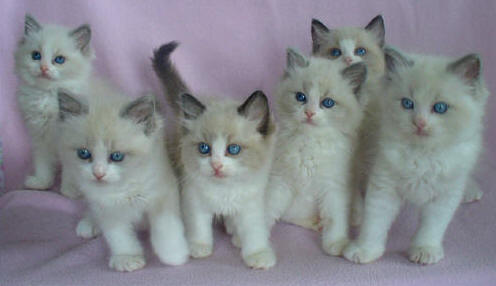
Blue and Seal Bicolor Ragdoll Babies
![]()
Ragdoll Patterns:
Ragdolls come in three beautiful distinct patterns which come in all colors. See our Colors and Patterns Page for more details and pictures!
Colorpoint: The Colorpoint Ragdoll is your basic pointed cat. Colorpoints have darker point colors on their ears, tail, legs, and mask with a lighter variation of the same color to their body. Colorpoint Ragdolls have no white on them.
A Seal Colorpoint Ragdoll is pictured below.
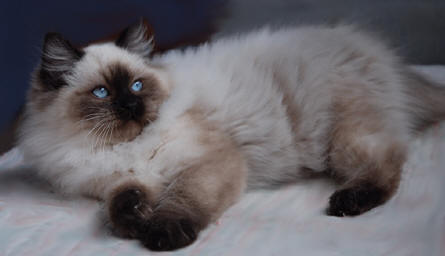
Mitted: The Mitted Ragdoll has all the basics of the Colorpoint but with a little extra pizzazz.
The Mitted has matching white mittens on the front feet and white boots extending about mid-thigh on the back legs. The Mitted Ragdoll also has a white chin and chest with a white strip of varying widths running down the belly and lower abdomen. Mitteds may also have a blaze of white on their forehead and/or nose.
A Seal Mitted Ragdoll is pictured below.
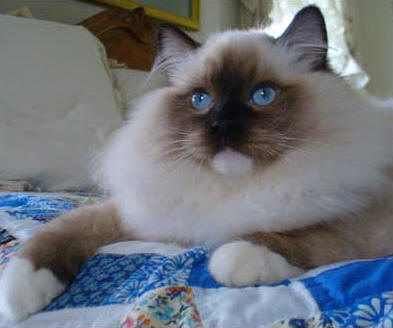
Bicolor: The Bicolor Ragdoll is the flashiest of the three patterns. Bicolor meaning two colors have darker points to their ears, tail, and mask with their backs displaying a “saddle” with a lighter variation of the same color. The Bicolor has an inverted white “V” of varying heights and widths inside of the mask on their face. Their chins, chest, front and back legs, and belly are mostly or all white.
A Seal Bicolor Ragdoll is pictured below.
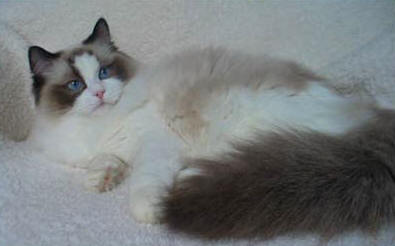
***Where as each pattern is described with the ideal Ragdoll markings in mind some Ragdolls may have less than perfect markings which may disqualify or penalize them in the show hall. These Ragdolls are considered “Pet Quality” and will be altered. Ragdolls with perfect or near perfect markings that come as close as possible to meeting the Ragdoll standards as described by the different cat associations (CFA, TICA, ACFA, etc.) are considered “Show Quality”. These Ragdolls will also be altered however will be given showing rights. On occasion we offer “Breeding Quality” Ragdolls to registered Ragdoll catteries only.
![]()
Ragdoll Grooming:
The Ragdoll coat is medium to long in length and is soft, silky, and almost bunny-like in texture. Their coat is low shedding, almost non-matting, and very easily maintained. It is recommended to comb your Ragdoll at least once a week, with an increase to at least twice a week during the shedding seasons (1-2 weeks during spring and fall). We also recommend a type of coat conditioner (such as Miracle Coat) when you comb. It helps keep the coat moisturized, soft, and smelling great! You also should practice regular nail trimming from the time your kitten is very young. At least twice a month is recommended. Although Ragdolls are not destructive cats and prefer to use a scratching post this will help prevent any undesirable accidental clawing incidents.
A Seal Bicolor Ragdoll is pictured below.
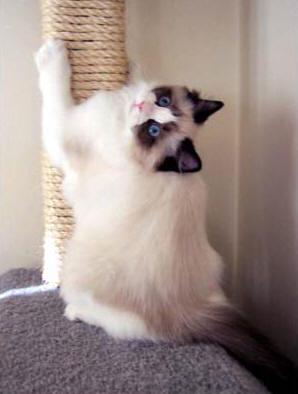
![]()
Ragdoll Temperament and Characteristics:
One of the biggest reasons the Ragdoll has become so well known is for its relaxed and easy going temperament. Ragdolls are a trusting and loving cat. They are highly domesticated and many do not posses the “fight” instinct nor do they use their claws for self defense. For these reasons the Ragdoll must be a strictly indoor cat! The relaxed, trusting nature of the cat is also why a lot of Ragdolls posses the ability to go limp or floppy when picked up. They lie relaxed and almost motionless in your arms like a child’s rag-doll, hence their name.
A Blue Mitted Ragdoll is pictured below.
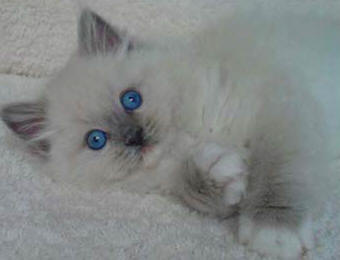
![]()
Ragdolls can also be very dog like giving them the nickname of Puppy-Cats. Their loyalty to you will find them waiting at the door for you to return home. They will follow you from room to room and insist on “helping” you with all of your tasks. They are smart cats and many easily learn your favorite dog tricks such as “sit pretty” and “fetch” with a favorite toy. Most highly enjoy a good belly rub.
Ragdolls tend to not be big jumpers and are easily trained to stay away from off limit areas such as tables and counters. They seem to prefer to stay close to the ground although the do treasure those high place just for them such as a cat tree or the back of the couch. They are a quieter breed of cat which prefers using purrs, birdcalls, and soft mews as opposed to loud meows.
The Ragdoll is an ideal family pet making special bonds with each member of the family. They adapt easily to just about any type of household whether it be a quiet home with only one or two members of the family or a loud, busy home with children and /or other pets and anything in between.
Ragdolls can also be very curious at times. They LOVE playing in bags and boxes. If you open a closet door or cabinet they are usually right inside checking out this new adventure. They like to watch birds, fish and T.V., and love to get new toys, so it is good to provide them with something to keep their minds busy. They are also very smart and can learn to open cabinets and doors. But you know what they say about curiosity and the cat, so if you have a Ragdoll please “child-proof” your home for his/her safety.
- A Blue Bicolor Ragdoll
- Seal Colorpoint Ragdoll
- Blue Bicolor Ragdolls
- Ragdolls are very playful
***Although the temperaments and characteristics described are true to the Ragdoll breed in general each Ragdoll is a unique individual and will develop their own blend of some or many of the characteristics described. ***
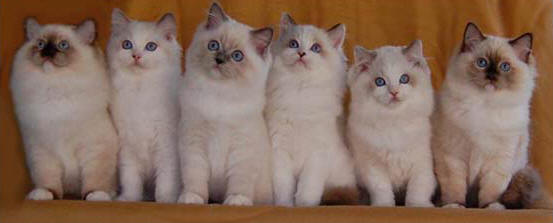
![]()
